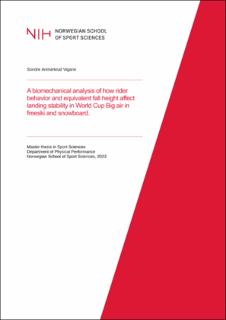| dc.description.abstract | Purpose: This study aimed to examine the impact of equivalent fall height (EFH) and rider behavior on landing stability among snowboard and freeski World Cup athletes participating in a Big air event. Furthermore, the study aimed to identify the predictive variables associated with EFH. Landing stability was utilized as a surrogate measure for injury risk. Methods: The project included a total of 97 elite athletes. Data collection occurred during the 2016/2017 season at a Big air event held in Mönchengladbach, Germany. A tachymeter-based measurement system (QDaedalus) and computer vision (CV) were employed to track and reconstruct a three-dimensional model of the athlete’s center of mass (COM) trajectories. These trajectories were then used to calculate various physical variables such as EFH, horizontal jump distance, landing angle, drop height, pop, and VParallel. Additionally, a qualitative assessment of rider behavior and landing stability was conducted, incorporating factors such as average angular velocity (ωavg), axial motions, the direction of rotation, and rider orientation. Logistic regression was performed to investigate the variables that influenced landing stability, while linear regression was utilized to identify variable predictors of EFH. Results: Snowboarders exhibited a significantly higher incidence of falls, bad landings (p<0,001,) and unbalanced landings (p<0,05) in comparison to skiers. This disparity could potentially be attributed to differences in the equipment attachment. Snowboarders have both legs attached to the board in a fixed position, which limits their ability to compensate for imbalances to a lesser extent compared to skiers. None of the variables examined were found to be significant predictors of landing stability in either freeski or snowboarding. Drop height and landing angle emerged as significant EFH predictors in freeski and snowboard (p<0,001). Conclusion: The elevated EFH values, which were observed to approximately meet the maximally recommended United State Terrain Park Council (USTPC) criterion of 1,5 meters, might diminish the influence of rider behavior factors on landing stability. The step-down jump resulted in remarkable EFH values, emphasizing the significance of designing a landing angle that aligns with the athlete’s flight trajectory. This design consideration is crucial to ensure compliance with USTPC criteria and uphold athlete safety. | en_US |
